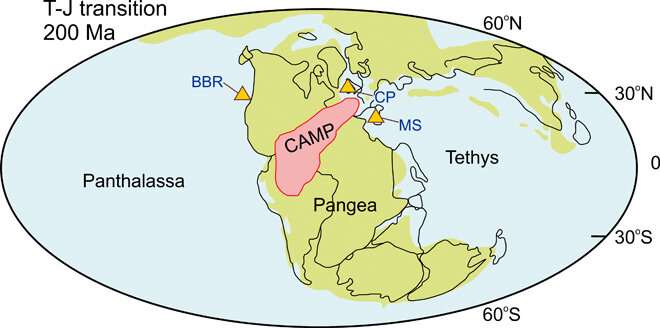September 10, 2020 report
Study of ancient rocks suggests oxygen depletion in oceans led to end-Triassic mass extinction

A team of researchers from the U.K., China, and Italy has found evidence that suggests oxygen depletion in the world's oceans led to the end-Triassic mass extinction. In their paper published in the journal Science Advances, the group describes their study of ancient rocks found in multiple locations around the world.
Prior research has shown that approximately 201.3 million years ago, a massive die-off of species occurred, ending the Triassic period and starting the Jurassic. Scientists have argued over the reason for the die-off and have settled on two possibilities: volcanic activity and ocean anoxia (loss of dissolved oxygen in the water). In this new effort, the researchers searched for evidence of the later.
The work involved obtaining rock samples from British Columbia, Sicily and Northern Ireland identified as having been at the bottom of the sea during the Triassic period. They then tested the rocks to see if they could find evidence of oxygen level changes in the ocean during the late Triassic. Their testing consisted of measuring the ratio of two major sulfur isotopes: 32S and 34S. Both are compounds that become trapped in limestone or other carbonate minerals.
Because of the nature of sulfur, the ratio of 34S to 32S is higher when there is less oxygen in the water, compared to normal levels. Thus, to determine the amount of oxygen in ocean water before during and after the end-Triassic mass extinction, the researchers simply measured the sulfur ratios in rock that existed in the ocean at that time. The researchers found what they describe as "large spikes" in the rocks from all three sites—a strong indication that ocean oxygen levels dropped dramatically during the time period when the mass extinction occurred.
The researchers also proposed a scenario that might have led to ocean oxygen levels dropping. They suggest that volcanic eruptions releasing huge amounts of carbon dioxide might have led to global warming, including sea temperatures. They note that warmer water has less oxygen, but that sea creatures living in that warmer water would require more oxygen to survive. Most could not find it, and therefore perished.
More information: Tianchen He et al. An enormous sulfur isotope excursion indicates marine anoxia during the end-Triassic mass extinction, Science Advances (2020). DOI: 10.1126/sciadv.abb6704
Journal information: Science Advances
© 2020 Science X Network




















